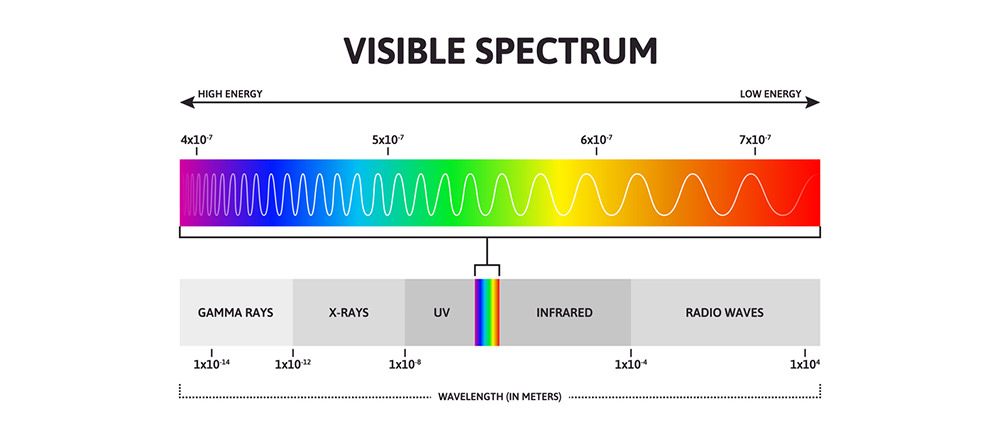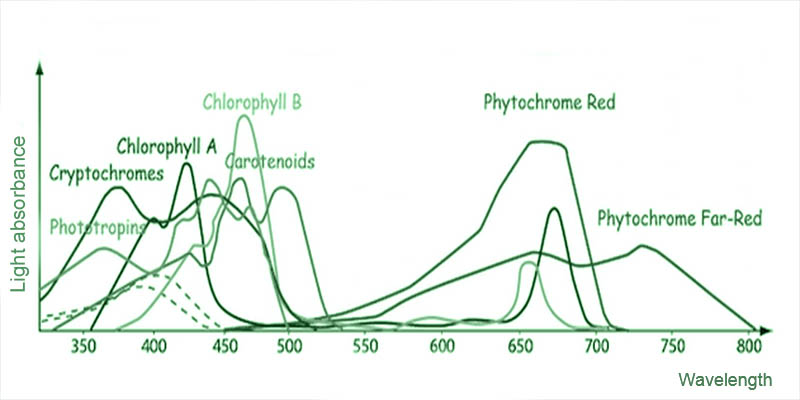Action Spectrum VS Absorption Spectrum, What Are the Differences
As known, plants absorb light and convert it into energy for their growth and development. Humans can only see the light of the visible range (400nm - 700nm) while plants can ‘see’ wavelengths beyond the visible range. The wavelengths ranged from 400nm to 700nm are mostly used by plants for photosynthesis. Thus the visible light is called photosynthetically active radiation (PAR range).
Although plants absorb light of different wavelengths, the absorption of different light colors relies on the help of various pigments. When it comes to plant lighting, it seems the action spectrum and absorption spectrum are nearly identical. But action spectrum and absorption spectrum are different. Moreover, knowing the differences between action spectrum and absorption spectrum help us understand the light that plants received and which one is beneficial for their growth and development. If you want to learn more about action spectrum and absorption spectrum, just read further.
What is the action spectrum
The action spectrum is also known as photosynthetically active radiation or PAR range. It refers to the effectiveness of a range of wavelengths to promote photosynthesis. In other words, the action spectrum is the light that plants use most for photosynthesis. It shows the most efficient light regions for photosynthesis are the red light (600 - 700nm), followed by the blue light (400 - 500nm), and then the green light (500 - 600nm). So in conclusion, the red, blue, and green light (wavelengths between 400 - 700nm) are photosynthetically active and are used most by plants.
The action spectrum tells us the light region that stimulates photosynthesis and makes plants become more productive. That is the reason why most LED grow lights are designed with spectrum in PAR range while containing more red light and blue light.
>> Contact Us To Get Your Efficient Horticulture Lighting Solutions >>

What is the absorption spectrum
The absorption spectrum reveals the range of light plants absorb. Plants absorb different light colors with the help of pigments. The cellular and molecular make-up of plants decides the range of the absorption spectrum. Thus, the absorption spectrum differs from species. The most common analyzed pigments are those related to photosynthetic including chlorophyll A, chlorophyll B, and carotenoids. Chlorophyll A absorbs wavelengths of violet, blue, orange, and red light. While chlorophyll B has an absorption spectrum of blue, green, orange, and red light. Carotenoids, however, have an absorption spectrum between the wavelengths of violet, blue, and green light.
Although plants normally absorb all colors of light, the absorption of green wavelengths is much poorer than red and blue light. When plants are hit with sunlight, only a little green light is absorbed and most of them is reflected back to our eyes. That is why most plants appear green to our eyes.

What are differences between action spectrum and absorption spectrum
The action spectrum for photosynthesis is similar to the absorption spectrum for chlorophyll. Because both of them are important for the photosynthesis process. But it is important to note that not all pigments contained in plants are helpful to the photosynthesis process. In addiction, not only chlorophyll A and B, but also other molecules play essential roles in the process of photosynthesis. The main differences between action spectrum and absorption spectrum is that action spectrum shows the wavelengths used by plants for photosynthesis, whereas the absorption spectrum reveals the wavelengths that are most absorbed by specific molecules. Light that is absorbed by plants and used by plants is different. Here are some differences between action spectrum and absorption spectrum:
|
Action spectrum |
Absorption Spectrum |
|
The wavelengths (color of light) most used by plants to perform photosynthesis. |
The amount of light of different wavelengths absorbed by a pigment. |
|
It represents the relationship between photosynthetic activity in relation to different wavelengths of light. |
It represents the relationship between quality of light and absorbing capacity of pigments |
|
The maximum photosynthesis occurs in blue and red light. |
Chlorophyll absorb blue and red light, carotenoids absorb violet, blue, and green light. |
|
It can be studied by measuring the amount of oxygen evolved, or amount of carbon dioxide absorbed, amount of NADP+ reduced. |
It can be studied using the spectrometer. |
The sense of knowing the differences between action spectrum and absorption spectrum is to provide artificial lighting with specific wavelengths to match the needs of plants. Since grow lights convert electricity into the wavelengths that contribute to photosynthesis instead of a broad spectrum, growers can achieve higher yields with lower energy costs.

